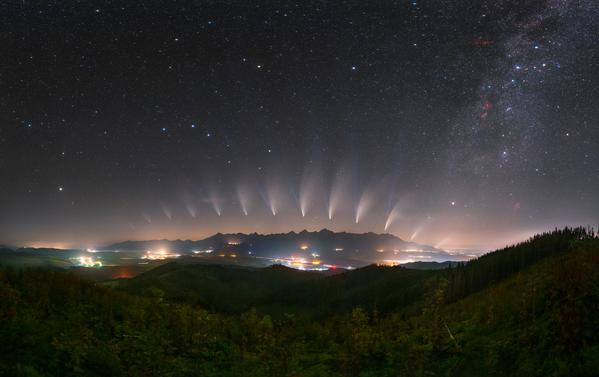This page describes an image Neowise's metamorphosis, by Tomáš Slovinský and Petr Horálek, Slovakia
Caption:
First place in the 2021 IAU OAE Astrophotography Contest, category Comets.
This image uses the chronophotography technique to capture the evolution of the comet C/2020 F3 (Neowise) over time, as it became visible in the northern skies in July 2020. Orbits of comets are extremely elliptical, which means that during part of their orbit they get close to the Sun. As a comet approaches the Sun, it gets heated, releases gas and dust creating an envelope or coma around the nucleus. The solar wind and photons (particles of electromagnetic radiation) interact with the coma producing the cometary tail, which can be seen clearly in this image. The tail of a comet always points away from the Sun, and extends as much as tens of millions of kilometres. This tail has two parts: the relatively straight bluish gas (ion or plasma) tail, which is made up of charged particles interacting with the magnetic fields of the solar wind; and the whitish dust tail compose of very small dust particles that are pushed by the radiation pressure from the Sun into a curve due to their slower speeds. Two regions in the Solar System are often associated with being “storehouses” of comets: the Kuiper Belt and the Oort Cloud. Comets with periods up to about two hundred years come from the Kuiper belt, a reservoir of cometary nuclei material with a disk-like shape located beyond Neptune. Longer period comets come from the Oort cloud, another huge reservoir of icy objects, with a spherical shape surrounding the Solar System. The outer limit of the Oort Cloud is not known as yet, but it could be as much as 10 thousand times the Sun-Earth distance, or even more. Due to gravitational disturbances, some of these cometary nuclei might be ejected towards the inner regions of the Solar System, sometimes approaching the Earth, offering some of the most spectacular views of a celestial body. The image also shows some prominent constellations and asterisms like the Big and Little Dippers, and also the North (Pole) Star – Polaris.
Credit:
Tomáš Slovinský and Petr Horálek/IAU OAE
DOI: 10.5281/zenodo.5290117
Related glossary terms:
Comet
Categories:
Naked Eye Astronomy
, Solar System
License: Creative Commons Attribution 4.0 International (CC BY 4.0) Creative Commons Attribution 4.0 International (CC BY 4.0) icons
The media file captions presented on the OAE website were written, translated and reviewed by a collective effort from the OAE, the OAE Centers and Nodes, the OAE National Astronomy Education Coordinators (NAECs) and other volunteers. You can find a full list of credits for our translation project here. All media file captions are released under a Creative Commons CC BY-4.0 license and should be credited to "IAU OAE". The media files themselves may have different licenses (see above) and should be credited as listed above under "credit".
Captions in Different Languages:
Caption: Primo posto al concorso di astrofotografia IAU OAE 2021, categoria Comete.
Questa immagine utilizza la tecnica della cronofotografia per catturare l'evoluzione della cometa C/2020 F3 (Neowise) nel tempo, quando è diventata visibile nei cieli settentrionali nel luglio 2020. Le orbite delle comete sono estremamente ellittiche, il che significa che durante una parte della loro orbita si avvicinano al Sole. Quando una cometa si avvicina al Sole, si riscalda e rilascia gas e polvere creando un involucro o chioma intorno al nucleo. Il vento solare e i fotoni (particelle di radiazione elettromagnetica) interagiscono con la chioma producendo la coda cometaria, chiaramente visibile in questa immagine. La coda di una cometa punta sempre lontano dal Sole e si estende fino a decine di milioni di chilometri. Questa coda è composta da due parti: la coda relativamente diritta di gas bluastro (ioni o plasma), che è costituita da particelle cariche che interagiscono con i campi magnetici del vento solare; la coda biancastra di polvere, composta da particelle di polvere molto piccole che sono spinte dalla pressione delle radiazioni del Sole in una forma curvata a causa della loro velocità ridotta. Due regioni del Sistema solare sono spesso associate a "magazzini" di comete: la Fascia di Kuiper e la Nube di Oort. Le comete con periodi fino a circa duecento anni provengono dalla Fascia di Kuiper, un serbatoio di materiale cometario a forma di disco situato oltre Nettuno. Le comete con periodi più lunghi provengono dalla Nube di Oort, un altro enorme serbatoio di oggetti ghiacciati, di forma sferica, che circonda il Sistema solare. Il limite esterno della nube di Oort non è ancora noto, ma potrebbe essere pari a 10 mila volte la distanza Sole-Terra, o anche di più. A causa di perturbazioni gravitazionali, alcuni di questi nuclei cometari potrebbero essere espulsi verso le regioni interne del Sistema solare, talvolta avvicinandosi alla Terra, offrendo alcune delle viste più spettacolari di un corpo celeste. L'immagine mostra anche alcune costellazioni e asterismi di rilievo come il Grande e il Piccolo Carro e la stella Polare.
Credit: Tomáš Slovinský e Petr Horálek/IAU OAE
Related glossary terms: Cometa Caption translation status: Approved by a reviewer
Caption translators: Giuliana Giobbi, Francesco Salvestrini
Caption reviewers: Rosa Valiante, Rodolfo Canestrari, Raffaella Ferretti









